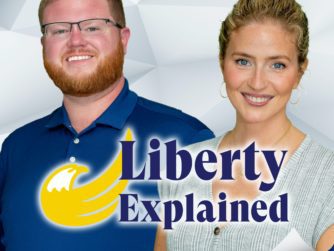We recently celebrated President’s Day. As we continue to watch the development of the Trump presidency, this seems like an opportune time to review a brief history of the office, the growth of executive power, and what might be in store for us in the decades to come.
During the hot summer of 1787, the Constitutional Convention was held over a period of months in Philadelphia. Interestingly, this convention and the result of it have disputed legitimacy due to the structure of the Articles of Confederation, but that is a topic for a different discussion. The United States Constitution installed a single executive, the president of the United States, after a heated debate on the appropriate structure for the newly formed Executive Branch.
In a unanimous decision by the Electoral College, George Washington was elected to be our first president in 1789. Since his election, we have seen periods of both stability and explosive growth in the powers assumed and exercised by the president. There is a pattern to this. About every 35-40 years, we see a shifting expansion of this power. Let’s review these turning points and ask what this might mean for a Trump presidency.
1789: Election & Inauguration George Washington – 1st President of the United States
I recently listened to a wonderful audiobook called Washington: A Life by Ron Chernow. This Pulitzer Prize winning book gave me a fresh and detailed look at our nation’s first president. His incredible leadership permeates his life story and provides interesting insight into the early days of our government. As libertarians, many of us praise our Founding Fathers for creating a system of government that is designed for limited power. The desire for a stronger central government than provided for by the Articles of Confederation made many lovers of liberty extra cautious of the potential for monarchical or tyrannical power to emerge from the Executive Branch. Washington both held these views and limited his actions when other men would have seized power.
Washington was not hands-off. He took decisive action via executive power to thwart the Whiskey Rebellion and vested power in the Executive Branch in places, such as the formation of the Cabinet, where the Constitution was ambiguous. Despite his own strong ambitions, his leadership and devotion to the republic arguably allowed this new government to get off to a start setting the tone for a strong legislative branch balanced by the office of the president in the spirit of republicanism and limited government. However, make no mistake, those who were wary of a strong executive did worry about the scope of power created by Washington (and notably his right-hand-man Alexander Hamilton) despite the often self-imposed limits of the office at that time. Still, this was a gigantic shift in executive power versus the previous federal government.
1828 (39 years later): Election of Andrew Jackson – 7th President of the United States
Andrew Jackson marked a new era of the president on many levels. After securing the plurality of electoral votes the crazy election of 1824 but losing the presidency to John Quincy Adams in the House of Representatives, Jackson returned in 1828 to exact his revenge in win the nation’s highest office. Jackson is sometimes seen as a political outsider, but he was hardly a newcomer to politics. He was Tennessee’s first representative to the House in 1797, selected U.S. senator twice, appointed to be military governor of Florida, led the Tennessee militia, and served in the Tennessee Supreme Court.
As a famous war hero due to his efforts in the Battle of New Orleans at the end of the War of 1812, Jackson catapulted his popularity and made his way to the White House. Jackson was an authoritarian and built a new type of presidency. He was still an outsider of sorts: he was the first president who was not from Virginia or named Adams; he played no role in the American revolution or Washington administration, and he was not born into a family of wealth or distinction. Prior to his presidency, Jeffersonian-era Treasury Secretary Albert Gallatin described Jackson as “altogether unfit for the office” of the president due to his “habitual disregard of laws and constitutional provisions.”
Jackson went on to drive a policy of Indian removal including the famous Trail of Tears, undermine state power in the Nullification Crisis, make significant use of the veto power, and establish a system of political patronage with his political architect and presidential successor Martin Van Buren which set the table for graft and abuse for generations. While playing the card of a true republican-style man-of-the-people, Jackson capitalized on his power and changed the presidency and American politics forever.
1864 (36 years later): Re-Election of Abraham Lincoln – 16th President of the United States
Abraham Lincoln is lauded by historians as one of, if not the best, presidents in our nation’s history. Among libertarian circles, you will often find those who like to paint Lincoln as one of the worst presidents in our history due to the expansive powers he assumed during the Civil War. My intention in placing Lincoln in this list is not to debate whether he was a good or bad president, but that the nature of his actions certainly laid the table for future executive power.
His re-election in 1864 is chosen for this list as it solidified the electorate’s choice to continue the consolidation of power to the sitting wartime president under the notion that the preservation of the Union is both paramount to the federal government and can be ensured by the strength of one individual. Many northern leaders opposed Lincoln in the run-up to his re-election, but ultimately the power of incumbency in a time of crisis overshadowed concerns. Lincoln was a political animal, a pragmatist above principle, and cemented the view of the presidency as one of individual leadership.
1902 (38 years later): Assumption of Office by Theodore Roosevelt – 26th President of the United States
William McKinley was assassinated early in his second term as president, and his new vice president (Garret Hobart, McKinley’s first VP, had died in late 1899) assumed the office. Teddy Roosevelt brought new ideas of the power of the President to his tenure. He was re-elected in 1904, declined to run in 1908, and then came back to run again in 1912 fracturing the Republican Party by challenging the incumbent William Howard Taft. Roosevelt was perhaps our first truly “imperial” President greatly expanding our navy, intervening in several foreign disputes, and even explicitly calling for America to exercise “international police power” in his address to Congress in 1904.
Roosevelt firmly believed in a strong executive which is described as the “stewardship theory” of the presidential power. This philosophy holds that, in his own words, “the executive power was limited only by specific restrictions appearing in the Constitution or imposed by Congress under its constitutional powers.” He stated that he “used every ounce of power there was in the office” and “acted for the common well-being of all people, whenever and in whatever manner was necessary.” His view of the presidency and brand of populism laid the groundwork for the progressive political movement in the United States removing many features of small government republicanism so favored by Washington, Jefferson, and Madison.
1940 (38 years later): 2nd Re-Election of Franklin Roosevelt – 32nd President of the United States
Franklin Roosevelt was not the first two-term president to seek a third term, but he was the first, and only, one to win. Most readers will know about the expansive growth of government under Roosevelt’s first term when his New Deal policies were implemented giving the federal government unprecedented authority in private sector affairs. While this alone would warrant consideration for inclusion in this list, it is Roosevelt’s legacy as a four-term president and the advancement of power exhibited in World War II that truly changed the presidency.
Woodrow Wilson’s administration rests in the middle of the Roosevelts’ and deserves note for many aspects of government expansion. But, Wilson, in may ways simply took Teddy’s powers to the next step. Franklin Roosevelt fused the primacy of the president that was trumpeted by his cousin with the expanding powers of the federal government implemented during the Wilson era to form a new office of the presidency. FDR’s critics were fearful of dictatorship as he entered a third term; the American people re-elected him with ease. But most notably, FDR cemented America’s role on the international stage, ushered in nuclear power, and provided the framework for a new America that has been followed for decades.
1980 (40 years later): Election of Ronald Reagan – 40th President of the United States
It was a little more challenging to make this pick. The post-FDR era has been full of presidents exercising vast amounts of executive authority. However, Ronald Reagan changed the presidency in ways similar to the presidents listed above like no one else since FDR. Reagan used his ability as a communicator along with the expanding popularity of television to create a new cult of personality around the office of president. This sowed the seeds for the 24-hour news cycle, increased partisanship, and the new flavor of American exceptionalism that has taken over politics in the last few decades.
Reagan often talked a good game on small government. But, deficits and debt soared during his tenure, the War on Drugs was put in to high gear, executive orders were bountiful, and he certainly did not shy way from military intervention on the international stage. He has become the icon of the Republican Party idolized by commentators and presidential hopefuls who aim to follow his brand of leadership to achieve the nation’s highest office.
So, what might this mean for Donald Trump?
If we follow the pattern, then the 2016 or 2020 election will bear the next president to be studied in this line of executive power. Donald Trump exhibits similar traits to many of the presidents in our list and uses rhetoric to suggest that he views the presidency as a vehicle to wield immense power. We have already gone far astray of the visions of a limited executive in a constitutional republic. George Washington took deliberate action to strike a balance between what was, in his eyes, too much and too little power. Several presidents since him have had far less regard for this balance. I do not have high hopes that Trump seeks to find this balance either. The question that many libertarians have is: will he use this power to root out corruption in the federal government or will he use it a destructive force against our liberties?



